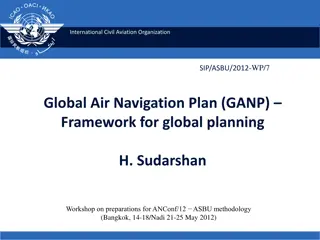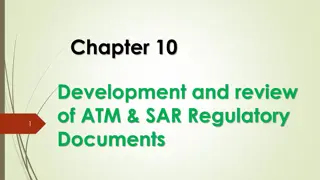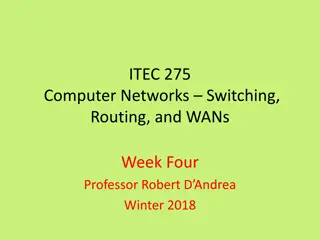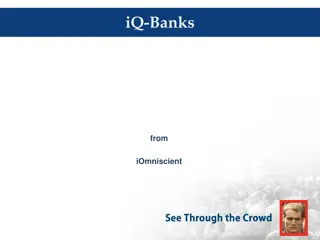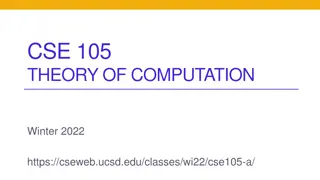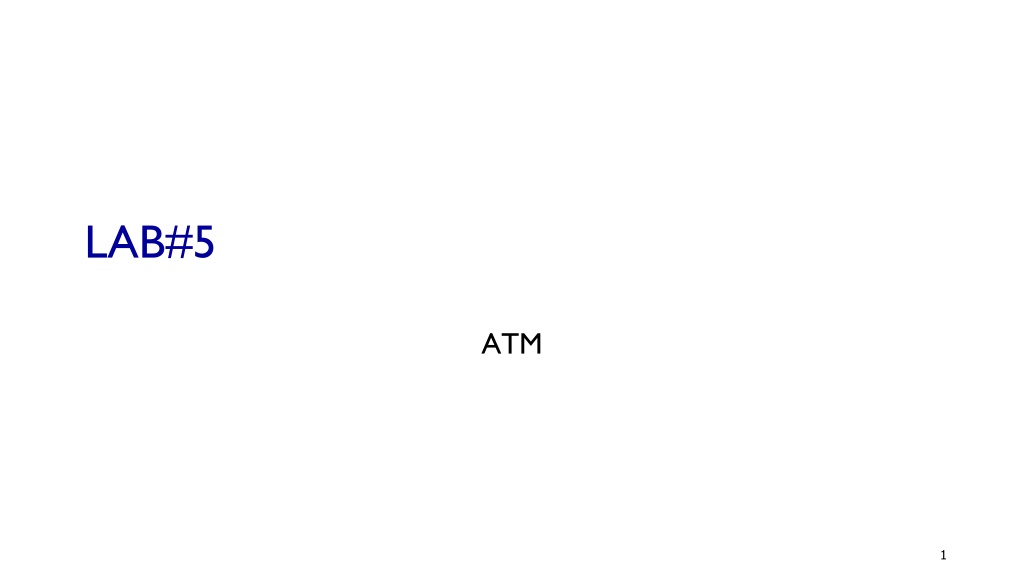
Understanding ATM Technology in Networking
Discover the benefits and features of ATM technology in networking, including its predictability, consistency, and use in real-time services. Learn how ATM compares to frame relay, its implementation in WANs, and adaptation layers for voice, video, and data traffic integration.
Download Presentation

Please find below an Image/Link to download the presentation.
The content on the website is provided AS IS for your information and personal use only. It may not be sold, licensed, or shared on other websites without obtaining consent from the author. If you encounter any issues during the download, it is possible that the publisher has removed the file from their server.
You are allowed to download the files provided on this website for personal or commercial use, subject to the condition that they are used lawfully. All files are the property of their respective owners.
The content on the website is provided AS IS for your information and personal use only. It may not be sold, licensed, or shared on other websites without obtaining consent from the author.
E N D
Presentation Transcript
LAB#5 ATM 1
Switching Technologies ISDN 2
ATM As ATM switches utilize very short, fixed-length cells, they process information much faster than frame relay switches. Fixed-length cells allow for Virtual Circuits (VCs) to be forwarded in hardware as opposed to utilizing processor cycles for this purpose. The fixed-length cells are enhanced with connection-oriented services. 3
ATM The predictability and consistency of transmission of ATM are the features that make this technology a good choice for transporting real-time services The lack of a predictable and consistent delivery of information was a key limitation of frame relay, which prevented the widespread use of this technology for converged applications. Access to the ATM core is typically provided by T-carrier services (T-1 or T-3) 4
ATM ATM vs. OSI 5
ATM Introduction ITU-T lead the standards development. ATM Forum ensures interoperability among private and public ATM implementations. ATM commonly used to implement WANs. DSL uses ATM for multiplexing and switching. ATM still used as a backbone in some IP networks. DCC 9th Ed. Stallings 7
Issues Driving LAN Changes Traffic integration Voice, video and data traffic Multimedia became the buzz word in the 1990s One-way batch Two-way batch One-way interactive Two-way interactive Quality of Service guarantees (e.g. limited jitter, non-blocking streams) LAN interoperability Mobile and wireless nodes Web traffic voice messages Mbone broadcasts video conferencing 8
Stallings High-Speed Networks Backbone 9
ATM Adaptation Layers Voice AAL A/D s1 , s2 Digital voice samples cells Video AAL Compression A/D cells compressed frames picture frames Data AAL cells Bursty variable- length packets Leon-Garcia & Widjaja: Communication Networks 11
Asynchronous Transfer Mode (ATM) Voice Data packets MUX Wasted bandwidth Images TDM 4 3 2 1 4 3 2 1 4 3 2 1 ATM 4 3 1 3 2 2 1 Leon-Garcia & Widjaja: Communication Networks 12
ATM ATM standard (defined by CCITT) was widely accepted by common carriers as mode of operation for communication (particularly BISDN). ATM is a form of cell switching using small fixed-sized packets. Basic ATM Cell Format 48 Bytes 5 Bytes Header Payload 13
ATM Conceptual Model - Four Design Assumptions 1. ATM network will be organized as a hierarchy. User s equipment connects to networks via a UNI(User-Network Interface). Connections between provided networks are made through NNI (Network-Network Interface). 2. ATM will be connection-oriented. A connection (an ATM channel)must be established before any cells are sent. 14
ATM Interfaces DCC 9th Ed. Stallings 15
ATM Connections two levels of ATM connections: virtual path connections (VPC) virtual channel connections (VCC) indicated by two fields in the cell header: virtual path identifier VPI virtual channel identifier VCI 16
ATM Virtual Connections Virtual Path Connection (VPC) bundle of Virtual Channel Connections (VCC) with same end points. DCC 9th Ed. Stallings 17
ATM Conceptual Model -Assumptions (cont.) 3. Vast majority of ATM networks will run on optical fiber networks with extremely low error rates. 4. ATM must support low cost attachments. This decision lead to a significant decision: to prohibit cell reordering in ATM networks. ATM switch design is more difficult. 18
ATM Cell Formats DCC 9th Ed. Stallings 19
Payload Type (PT) Field Coding DCC 9th Ed. Stallings 20
ATM Cell Switching 1 1 voice 67 Switch video67 2 N 1 25 32 75 67 video 25 32 voice 5 data 39 3 32 61 3 2 39 67 32 video 61 data 6 N video 75 N Leon-Garcia & Widjaja: Communication Networks 21
Two Levels of ATM Switches a VP3 VP5 a b ATM Sw 1 ATM Sw 2 b c ATM DCC c d e ATM Sw 3 VP2 VP1 d e ATM Sw 4 Sw = switch Digital Cross Connect Only switches virtual paths Leon-Garcia & Widjaja: Communication Networks 22
ATM Protocol Architecture ATM Adaptation Layers (AAL) the protocol for packaging data into cells is collectively referred to as AAL. Must efficiently package higher level data such as voice samples, video frames and datagram packets into a series of cells. Design Issue: How many adaptation layers should there be? 23
ATM Protocol Architecture Management plane Plane management Control plane User plane Layer management Higher layers Higher layers ATM Adaptation Layer ATM layer Physical layer Leon-Garcia & Widjaja: Communication Networks 24
ATM in the Protocol Stack User User information information AAL AAL ATM ATM ATM ATM PHY PHY PHY PHY End system End system Network Leon-Garcia & Widjaja: Communication Networks 25
Original ATM Architecture CCITT envisioned four classes of applications (A-D) requiring four distinct adaptation layers (1-4) which would be optimized for an individual application class: A. Constant bit-rate applications CBR B. Variable bit-rate applications VBR C. Connection-oriented data applications D. Connectionless data application 26
ATM Architecture An AAL was further divided into: Convergence Sublayer (CS) manages the flow of data to and from SAR sublayer. Segmentation and Reassembly Sublayer (SAR) breaks data into cells at the sender and reassembles cells into larger data units at the receiver. 27
Physical Layer ATM Adjustments ATM layer Transmission convergence sublayer Physical layer Physical medium dependent sublayer Physical medium 29
Original ATM Architecture The AAL interface was initially defined as classes A-D with SAP (Service Access Points) for AAL1-4. AAL3and AAL4 were so similar that they were merged into AAL3/4. The data communications community concluded that AAL3/4was not suitable for data communications applications. They pushed for standardization of AAL5 (also referred to as SEAL the Simple and Efficient Adaptation Layer). AAL2 was not initially deployed. 30
Revised ATM Service Categories Class Description Example CBR Constant Bit Rate T1 circuit RT-VBR Real Time Variable Bit Rate Real-time videoconferencing Multimedia email NRT-VBR Non-real-time Variable Bit Rate ABR Available Bit Rate Browsing the Web UBR Unspecified Bit Rate Background file transfer 32
QoS, PVC, and SVC Quality of Service (QoS) requirements are handled at connection time and viewed as part of signaling (e.g., RSVP). ATM provides permanent virtual connections and switched virtual connections. Permanent Virtual Connections (PVC) permanent connections set up manually manager. Switched Virtual Connections (SVC) set up and released on demand by the end user via signaling procedures. by network 33
AAL 1 (b) CS PDU with pointer in structured data transfer 47 Bytes AAL 1 Pointer 1 Byte 46 Bytes optional (a) SAR PDU header SNP Seq. Count CSI 1 bit 3 bits 4 bits Leon-Garcia & Widjaja: Communication Networks 34
AAL 1 User data stream Higher layer b1 b2 b3 CS PDUs Convergence sublayer 47 47 47 SAR PDUs SAR sublayer H H H 1 47 1 47 1 47 ATM Cells ATM layer H H H 5 48 5 48 5 48 Leon-Garcia & Widjaja: Communication Networks 35
AAL 3/4 CS and SAR PDUs (a) CPCS-PDU format Header Trailer AL Etag Length CPI Btag BASize Pad CPCS - PDU Payload 1 1 2 (bytes) 1 - 65,535 0-3 1 1 2 (bytes) (bytes) (b) SAR PDU format Header (2 bytes) Trailer (2 bytes) LI CRC ST SN MID SAR - PDU Payload 2 4 10 44 (bits) 6 10 (bits) (bytes) Leon-Garcia & Widjaja: Communication Networks 36
AAL 3/4 Higher layer Information User message Service specific convergence sublayer Assume null Pad message to multiple of 4 bytes. Add header and trailer. Common part convergence sublayer H Information T PAD 4 4 Each SAR-PDU consists of 2-byte header, 2-byte trailer, and 44-byte payload. SAR sublayer 2 44 2 2 44 2 2 44 2 ATM layer Leon-Garcia & Widjaja: Communication Networks 37
AAL 5 Convergent Sublayer Format UU CPI Length CRC Pad Information 0 - 65,535 0-47 1 1 2 4 (bytes) (bytes) SAR Format ATM Header 48 bytes of Data 1-bit end-of-datagram field (PTI) Leon-Garcia & Widjaja: Communication Networks 38
AAL 5 Information Higher layer Service specific convergence sublayer Assume null Common part convergence sublayer Information T PAD SAR sublayer 48 (0) 48 (0) 48 (1) ATM layer Leon-Garcia & Widjaja: Communication Networks PTI = 1 PTI = 0 PTI = 0 39
STM-1 (STS-3) Payload for SDH-Based ATM Cell Transmission 40
ATM Summary Motivation for ATM Architecture Four Design Assumptions ATM Hierarchy UNI,NNI, VPI, VCI, two switch levels Old ATM Design Convergence Sublayer (CS), Segmentation and Reassembly Sublayer (SAR) ATM Adaptation Layers AAL1-4 42
ATM Summary New ATM Design PVC, SVC AAL Details AAL1, AAL3-4, AAL5 Multi-Protocol Layer Switching (MPLS) 43










